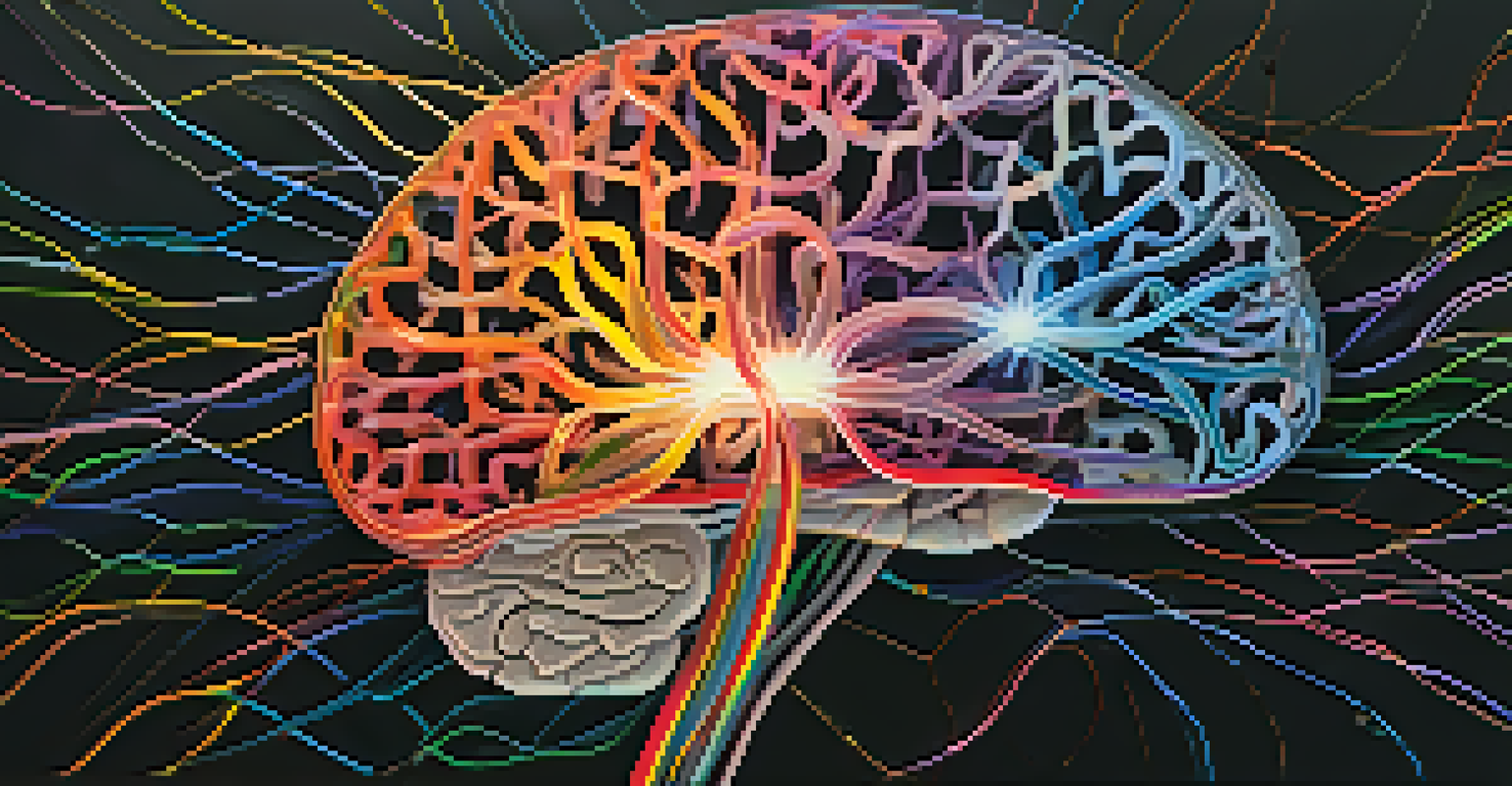Neuroscientific Insights into Entheogens and Pain Perception

Understanding Entheogens and Their Uses
Entheogens are substances that induce altered states of consciousness, often used in spiritual or therapeutic contexts. Examples include psilocybin, found in certain mushrooms, and ayahuasca, a brew rich in DMT. Historically, these compounds have been employed in various cultures for healing and introspection, illustrating their long-standing significance.
Psychedelics can help us see the world in a new way, allowing us to confront our pain and suffering with fresh perspectives.
In recent years, there's been a resurgence of interest in the potential therapeutic benefits of entheogens, particularly in treating mental health conditions like PTSD and depression. Researchers are now investigating their role not just in mental wellness but also in pain management. This shift is prompting a closer look at how these substances interact with the brain's pain perception pathways.
By examining the neuroscience behind entheogens, we can better understand their effects on both the mind and body. This exploration opens doors to innovative treatment options, particularly for individuals experiencing chronic pain. As the conversation around entheogens evolves, it’s crucial to ground our understanding in scientific research.
The Neuroscience of Pain Perception
Pain perception is a complex process that involves the brain, nervous system, and various biological factors. Essentially, when you experience pain, your body sends signals through the nervous system to your brain, which interprets these signals as discomfort. This intricate system can be influenced by numerous factors, including emotions, context, and even previous experiences with pain.

Neuroscientists have identified specific brain regions that play a pivotal role in pain processing, such as the anterior cingulate cortex and the insula. These areas help the brain evaluate and respond to painful stimuli. Understanding how these regions work together can shed light on why some individuals experience pain more intensely than others.
Entheogens Aid Pain Management
Entheogens like psilocybin are being explored for their potential to alleviate chronic pain and improve mental health.
This variability in pain perception is where the potential of entheogens comes into play. By modulating the brain's response to pain, these substances might help alter how we experience discomfort, providing relief for many. As we delve deeper into this relationship, the intersection of neuroscience and entheogens could lead to significant advancements in pain management.
How Entheogens Affect the Brain's Pain Pathways
Entheogens interact with neurotransmitter systems in the brain, particularly serotonin receptors, which are crucial for mood regulation and pain perception. For instance, psilocybin has been shown to increase serotonin levels, which can lead to an altered experience of pain. This neurochemical shift may help explain why some users report decreased pain sensitivity following entheogen use.
The mind is not a vessel to be filled, but a fire to be kindled.
Moreover, studies suggest that entheogens may promote neuroplasticity, the brain's ability to reorganize itself by forming new neural connections. This plasticity can enhance the brain's coping mechanisms, potentially enabling individuals to manage pain more effectively. The idea of reprogramming how we perceive pain is an exciting frontier in both neuroscience and pain management.
By understanding these interactions, we can start to see how entheogens might provide not just temporary relief, but also long-term benefits for chronic pain sufferers. This evolving research landscape is urging scientists and healthcare professionals to rethink traditional pain management strategies. The potential for entheogens to reshape our understanding of pain is both promising and intriguing.
The Role of Set and Setting in Pain Management
One critical aspect of using entheogens for pain management is the concept of 'set and setting.' Set refers to the individual's mindset and emotional state, while setting encompasses the physical and social environment in which the substance is experienced. Both factors play a significant role in determining the overall experience and its effectiveness in managing pain.
When individuals approach entheogen use with a positive mindset and in a supportive environment, they often report more beneficial outcomes. This is especially relevant for pain management, as stress and anxiety can exacerbate the perception of pain. Creating an optimal set and setting can enhance the therapeutic effects of entheogens, making them more effective tools in pain treatment.
Neuroscience Sheds Light on Pain
Understanding how entheogens interact with pain pathways in the brain could revolutionize pain treatment strategies.
Understanding the importance of set and setting encourages a holistic approach to pain management. It highlights that the experience is not solely about the substance itself, but also about the individual's context and emotional state. As research continues, incorporating these elements into treatment plans may lead to better outcomes for those dealing with chronic pain.
Clinical Research on Entheogens and Pain Relief
Recent clinical research has begun to explore the potential of entheogens as viable options for pain relief. Studies have shown promising results, indicating that substances like psilocybin and MDMA can help alleviate chronic pain conditions. These findings are significant, as they present alternative treatments for patients who may not respond to conventional methods.
For example, a clinical trial involving psilocybin showed that participants experienced reduced pain levels and improved quality of life. Such outcomes suggest that entheogens could become a valuable addition to pain management strategies, especially for those suffering from conditions like fibromyalgia or complex regional pain syndrome.
As more research emerges, the hope is that entheogens will be embraced within medical frameworks, paving the way for new guidelines and therapeutic practices. The journey towards integrating these substances into mainstream healthcare is ongoing, but the potential for transformative change is evident.
Safety and Ethical Considerations in Entheogen Use
While the potential benefits of entheogens in pain management are exciting, it's essential to approach their use with caution. Safety and ethical considerations must be prioritized to ensure that these substances are used responsibly. This includes understanding the risks, potential side effects, and the importance of proper dosing.
Moreover, ethical concerns arise when considering the accessibility of entheogens for patients. As research progresses, it will be crucial to establish clear guidelines for their use in clinical settings. This ensures that individuals receive the support and monitoring they need while minimizing risks associated with self-administration.
Importance of Set and Setting
The effectiveness of entheogens in pain relief is influenced by the user's mindset and environment during use.
Creating a safe environment for entheogen use in therapeutic contexts highlights the need for trained professionals who can guide patients through their experiences. By addressing these considerations, we can help pave the way for more widespread acceptance and utilization of entheogens in pain management.
The Future of Entheogens in Pain Management
As we continue to unravel the complexities of pain perception and the role of entheogens, the future looks promising. Ongoing research is likely to reveal more about how these substances can be integrated into pain management strategies. This could usher in a new era of treatment options for those suffering from chronic pain.
Furthermore, as societal attitudes toward entheogens shift, we may see increased openness to exploring their therapeutic potential. This could lead to more funding and resources dedicated to studying their effects on pain and overall well-being. The dialogue surrounding entheogens is evolving, and with it comes the potential for innovation in healthcare.

Ultimately, the path ahead requires collaboration between researchers, healthcare professionals, and policymakers. By working together, we can ensure that the insights gained from neuroscientific research translate into safe and effective treatments for those in need. The future of entheogens in pain management is not just about substances; it’s about improving lives.